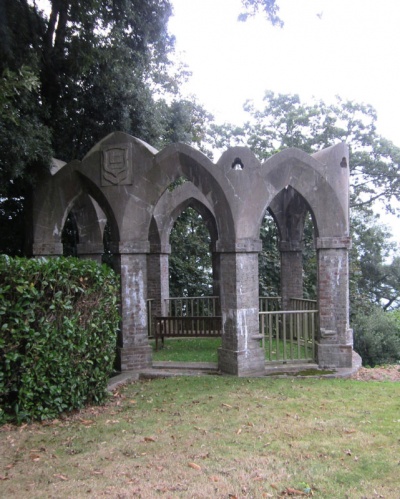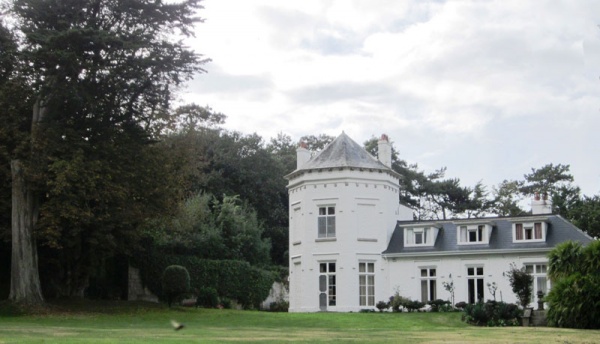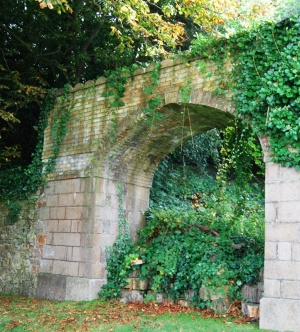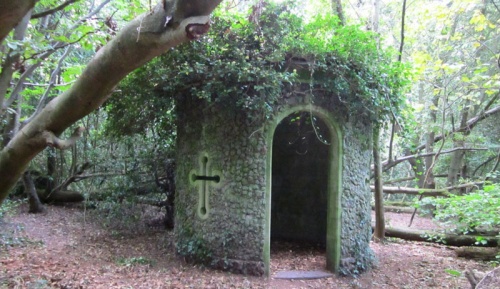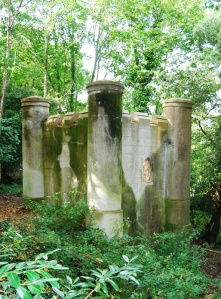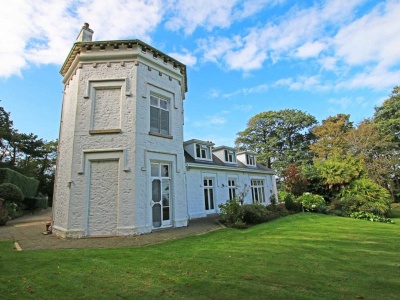Historic Jersey buildings
If you own this property, have ancestors who lived here, or can provide any further information and photographs, please contact us through editorial@jerripedia.org |
Property name
Rockmount de Moustiers
Location
Chemin d'Olivet, Trinity
Type of property
Described by HER as a 'marine pleasure pavilion'
Valuations
Sold for £2,025,000 in 2018
Families associated with the property
- Le Bailly: Josue Le Bailly built the original house in 1857-59
- Becquet: Owned in 1980s and 90s by Edgar John and Monica Becquet
Historic Environment Record entry
Listed building
A fine and extensive Picturesque and Sublime landscape around the remains of a unique marine pleasure pavilion, with a variety of Victorian Gothic garden buildings.
The sophisticated composition is unusually extensive in Jersey with at least three major garden buildings and various walls, massive terraces, gateways and the remains of other structures on a plateau and cliffside.
Some connecting paths are lost and the dramatic views obscured by woodland on the surrounding slopes, but the broad design linking the structures in a Picturesque manner is still evident.
This landscape is of the highest significance in Jersey. Related is Undercliff - a mid-19th century picturesque building which retains external character and sits well within the landscape.
The 1870s Baudoux photos, taken a year or two apart, show various structures which survive in the grounds and how they related to each other, including the Victorian Gothic gazebo exposed on a promontory, the crenellated wall around the forecourt, the surviving tower forming part of the house, a distant view of the circular tower and the lower entrance off Les Vielles Charrieres.
They are all set in a landscape recently planted with trees around the house.
A 1954 Evening Post report indicates that the house was struck by lightning and burnt out. It had been occupied by Germans during the Occupation.
Deeds show that the land was purchased and the house built by Josue Le Bailly 1857-59. The 1861 census notes a housekeeper and lodger. Le Bailley appears in the 1871 census at this property with family and two servants. As Jurat and banker, he was with the Jersey Mercantile Union Bank. He went bankrupt circa 1873 and lost the house in 1870s.
The Rockmount pavilion has similarities in Jersey with the Prince's Tower at La Hougue Bie, another 1790s Gothic eye-catcher and place of resort.
The National Trust for Jersey has deeds for the square tower which it owns. The deeds refer to a drive, avenues, a kitchen garden and water garden garden. They refer to a 'lodge' constructed in the cotils near to the public road leading to Bouley Bay – probably the nucleus of Undercliffe guesthouse.
Main house
Comprises a two-storey 'Tower of the Winds' and a lower wing attached to the north. These survive after the building was damaged during the Occupation and burnt in 1954. A further, taller Gothic tower formerly terminated the wing to the north, with a single storey verandah adjacent. The taller tower and verandah stood close to the edge of the garden terrace above a steep drop, but both have gone.
A service wing to the west is apparently later 20th century but may incorporate earlier fabric. The form of the entire building, based on towers and viewing verandahs, with limited residential accommodation, indicates that it was designed as a pleasure pavilion for excursions or short stays rather than as a country house.
The pavilion originally had panoramic views of the bay below to the north as shown on photographs of the 1870s. The views are now partly obscured by mature woodland on the originally open slopes below. The pavilion is reached down a curving drive from the south off Chemin d'Olivet. The long drive passes Rockmount Farm below to the west.
Near the farmhouse is a cylindrical building dated 1870 with blind windows. This may have been an eye-catcher from the drive, which reaches a pair of large cylindrical rendered gate piers with simple ogee caps.
A single-storey white coach house occupies the north side of the service court. Several metres in front of the gateway a cutting turns east off the drive alongside the crenellated service court wall. This was the original approach for visitors to the pavilion, but has been disused for many years. The cutting arrives at a large gate arch set in the south boundary wall.
At this point the dramatic sea view, which has been screened by the wall, opens up. This view through the arch is framed by the Victorian Gothic pavilion to the west and looks north across the garden lawn plateau past an open, Victorian Gothic-arched gazebo to the sea far below, and distant France. From the arch the drive formerly led north past the east, entrance front of the pavilion to arrive at the taller tower and verandah structure.
A further pair of gate piers stand on Vieilles Charrieres to the north-west of the house, alongside the earlier Rocher Brulé Guardhouse - the Powder Magazine). This seems to have given access to one or more paths up to the house to the south-east, and to the guardhouse, but their course and extent of survival is unclear.
Undercliff
Mid-19th century Victorian Gothic building. Appears to have originally been associated with Rockmount de Moustiers, one pathway from which emerges close to Undercliff. It may have been constructed as a lodge or shelter for visitors to the pavilion when they reached the distant bottom of the cliff via the terraced paths on their way to the shore.
Central historic core is single-storey, two-bay rectangle with cut corners, gabled porch to north. Lean-to entrance along west side. Bell housing on ridge.
Old Jersey Houses
Although within the timeframe for Vol Two, this historic property is not mentioned
